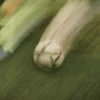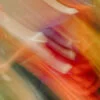Before a gray whale becomes a home, or a barrel of oil, or a metaphor, before she enters the realm of human meaning, she is a being complete in herself. Born as most gray whales are on an early January day off northwestern Mexico’s Baja Peninsula, her mother swims upside down, tail lifted, straining up, up, and she emerges head first not into water but into the air. Two thousand pounds of smooth pewter muscle born facing the sky. For the next three months, she practices pacing her breaths, the rise to the surface that keeps her from drowning in the water that is her home. In the calm lagoons, she grows more than a ton each month.
In April, the gray whale and her mother begin traveling north. They are often in sight of land, desert scrub becoming grassland, grassland turning to redwood groves and temperate rainforest as they move up the long arc of the North American continent. Their nearshore waters are punctuated by din: the ports of Los Angeles, Oakland, Seattle and Vancouver, each calling in its braided lanes of shipping traffic. In June, as they reach Unimak Pass in the Aleutian Islands, there is less clamor. They have swum more than 4,000 miles not for quiet but for the Bering Sea’s pastures of clams and tube worms below them in the muck, creatures that have rounded generations of the whale’s kin in blubber. As mother and calf scoop up the benthic riches, muddy blooms rise and trace across the sea’s surface.
In midsummer, the feeding path of the gray whale and her mother turns west toward Russia, toward good eating and shelter amid the bays and inlets of the Chukchi Peninsula. Their route meanders across the International Date Line, between today and tomorrow, yesterday and today. A demarcation as meaningless to a whale as a day – that contained pulse of light and dark – is to a human being in the endless sun of an Arctic summer.
In one such Arctic summer, I go to Chukotka, crossing the Date Line to the Bering Sea to look for whales. A historian by training, I had for several years been gathering records about gray whales and their meanings: Indigenous Yupik and Chukchi histories transcribed in St Petersburg; whalers’ logbooks in New Bedford, Massachusetts; Soviet economic plans on onion-skin paper in Vladivostok; the minutes of International Whaling Commission meetings in Washington DC. I spent that time imagining a whale, the contours of her life. Arriving in Chukotka, what I have are fragments. I am here, in the easternmost region of Russia, out of a kind of compulsive hope that in visiting the origin of these fragments, the place that has hosted centuries of varying relations between my species and the gray whale, I might find the line of a story. I am on the dawn-land edge of Eurasia looking for the plot.
I have a temporary apartment in Provideniya, a Soviet-era concrete town in the middle of Beringia National Park, its bays and beaches thick with whales and whaling sites. Seeing them is not simple. Alaska is close enough to be visible from points along this coast, so the Russian government considers all 737,700 square kilometers of the Chukotka Autonomous Okrug to be a border zone. Foreigners can travel here only with a propusk, a pass stamped by the governor and the Federal Security Service, or FSB. My propusk lists whether I have a curfew and what settlements I can visit. I also require minding; for anything further afield than a stroll, I am supervised by Nikolai Ettyne, a park guide. He makes our plans based on the weather and places in the park he has the vehicles and need to go. Or to avoid; one plan was scrapped because thousands of walruses had hauled themselves out onto the beach we were to see, and our presence might have caused them to stampede, crushing their young in a panicked heave toward the safety of the sea.
On a morning with fast-moving clouds and no rain, Nikolai collects me at my apartment. He is Chukchi, his ancestors native to this peninsula for generations, but not from here, he explains, as he was born 160 kilometers north in Lavrentiya. So it is good to travel with locals. Today, Alexei comes with us, driving the park’s Trekol. It is clear, once we are outside town, why we need the vehicle’s four-foot tires. Our way is along a narrow lake held by parallel ridges, their lichen-dark tops snow-boned, with barely a track ahead and no gentling of the incline where hill becomes lake. Americans, Alexei explains as water splashes over our hood, make roads. Russians make vehicles that do not require roads.
After a jolting hour, Alexei turns east. The Bering Sea is immediately on our left, the lake to the right; once, I think, the lake was a fjord, open to the sea, but the waves chose over some years to close the mouth with sand. Ahead is a low grassy hill, radiant green and rippling silver where the wind flips over the larkspur leaves. Clusters of beams rise pale and weathered. I take them to be wood, the edges worn ovoid and organic, but the beams are arrayed with the kind of order that marks to the eye things made by people.
As we walk up among them, I see that the beams were born. Slipped into the sea as the internal architecture of whales. The largest, ribs wide as I am, grew inside bowheads, the smaller come from grays. As we walk among them, I can see the bones are the ceilings of half-underground spaces. Many are sunk now below the larkspurs and monkshood, their sentinel ribs fallen to earth. These were houses, Nikolai says. This was the village of Eunmyn, that’s the Chukchi name. In Yupik, they call it Avan.
Avan: a name I know from libraries. People have made houses from whale along the Bering Strait for thousands of years; the practice is more recent in Avan, starting perhaps a millennia ago. Over the subsequent centuries, waves of inhabitants, drawn to this place because of its vantage for hunting whales, left strata of tools and dwellings. At a museum in St Petersburg, I saw photographs from the 1920s, when this was a Yupik settlement. The Avatmiit, the Yupik of Avan, lived in walrus-hide tents, not these bone homes, and did not trace their ancestry to the builders. When Vasilii Ankatagin, born here in 1924 or 1925, gave an account of Avan to anthropologist Igor Krupnik in the 1970s, he described it as ‘a good place: good hunting, many sea animals, fish, birds. To live here was good.’
There is a thrumming life still, among the houses where Vasilii must have run as a child, trampling the grasses as we do, hearing peregrine falcons keen as they ride the thermals high above. Perhaps he also touched the old whale bone, feeling how pliant it is with age. Or perhaps the sense of retained memories echoing up from these pits was too acute. I approach one house by crawling on my belly to peer down. In the dimness, the pale heavy brow of a whale’s skull holds back the earth. A bone wall. The people who lived here lived in the heads of whales.
In twenty-first-century New England, the time and place that I live, whales are usually the subject of awe and benevolence. I have had neighbors tell me they love them, sentiments that do not require regular observation or even the precision of a species. Here whales have been homes. A practical space, shelter and host to meals and births and deaths. Host to the least abstract kinds of love. Familial, romantic, parental. Here whales have made those intimacies, by giving people the capacity to live.
I pick myself up and walk with Nikolai down to the gray sandy beach. The sea, which is constrained less and less each year by the tempering presence of sea ice, is eroding the embankment that separates Avan from the water, exposing the skull foundations of another house. At my feet are pieces of bone. Some were clearly tools, things worked by human hands. Among them, incongruously bright, is a Yoplait yogurt container, the English on the sea-worn plastic still legible: fat-free strawberry.
We turn and look for whale spouts. You can tell the species by their plumes of breath, Nikolai tells me. Gray whales exhale in heart-shapes. The horizon is a clean line between blue-green water and a sky purpling with more rain. We see no whales.
I had seen whales on my way to Provideniya, the week before. I was in Nikolai’s village, Lavrentiya, waiting for the Kapitan Sotnikov, a small cargo ship heading for Provideniya, to set off. Young men in jeans and black windbreakers lashed bags of reindeer antlers onto the deck. Gathered from the inland herds and bound for China, Gena Zelensky told me. I had known Gena for some years; he is a master of Chukotkan logistics, fixer of my propusk and first port of call if things go awry. And they had. My plan was to fly straight to Provideniya from the regional capital of Anadyr, but there was an issue with my ticket – the sort of Russian bureaucratic problem that is never clear except in its outcome – and no empty seats for weeks. Gena improvised: I could go via Lavrentiya, where he lives in the summer, then take the Kapitan Sotnikov thirteen hours down the coast.
Lavrentiya was not listed on my propusk, however. As we waited for the ship, two plainclothes men from the security services asked me questions. We spoke in Russian. They mentioned my husband by name, casually, but also to make clear they knew things about me, things written in a file somewhere that I had not told them. After they left, Gena grumbled: what do they think you’re going to do, steal the damn reindeer? Spy on the whales?
That evening I climbed from the diesel-scented passenger area of the Kapitan Sotnikov, in search of a horizon. The view through the portholes kept moving up and sideways or down and backward, leaving my stomach in transit between. I tried focusing on the flat-screen television playing a dubbed version of Air Force One on a continual loop, which was worse. On deck the cold wind knocked me breathless but took the nausea with it. The evening was silvery, the late sun filtering through low clouds and breaking through, here and there, in streamers of light.
I thought about the FSB men. A century and a half ago, a person in Chukotka from New England was a kind of robber. They sailed from New Bedford and Nantucket and other port cities to skin the fat off of whales and refine it into lamp oil. The want for light decimated Atlantic whales, sending hunters to harrow the Pacific. In 1845, commercial ships reached Baja California, where gray whales give birth in sheltered inlets each winter, the southerly reach of a migration that brings them north to the Bering Sea in summer. Gray whales gave little oil, of poor quality. But whalers were paid their share of a voyage’s take only after its sale back in port. Every hand aboard knew the fastest way home was through killing any animal they could. So they lowered their small boats with the long harpoons into the nursery lagoons.
Within a few years, the whalers’ pursuit of oil trailed the grays north to the Bering Sea. Gray whales learned that the ships brought danger and attacked their tormenters. Whalers feared and hated them for it, calling them devil fish or scrags. In waters not far from the Kapitan Sotnikov’s route, one ship’s mate described ‘chasing devil fish’ only to have ‘the head of the boat knocked off’. So many meetings between whales and people took place in which the singular experience was terror. For such people, the meaning of a whale was reduced to present injury risked for future profit. And for the whale? As seen from the surface by her killers, she raged.
It did not stop the slaughter. Thirty years on from the first commercial kill, there were perhaps 4,400 gray whales left to migrate between Baja and the Bering Sea. The sea floor was littered with thousands of bones that never became houses. New England sailors did not even eat much whale. Many judged the Yupik and Chukchi who did as lacking ‘habits of industry’, as one captain wrote, in part because they killed few whales and did not sell the blubber. But the commercial fleet was aware that whale was to Chukotkans what grain was to New Englanders. In New Bedford newspapers, ship captains castigated themselves for the famines they had caused, for how commercial slaughter was ‘taking bread out of [Yupik and Chukchi] mouths’.
On the deck of the Kapitan Sotnikov, I watched three crepuscular sunbeams touch the rocking surface. In the shadows between, a back rose and split wide the sea in blasting exhale. A second followed. A mother gray and calf, by their sizes, and distinct from humpbacks or bowheads for having no dorsal fins. They were two of the nearly 27,000 gray whales then alive, descendants of those who survived being known by commerce.
What is it Herman Melville wrote? Quoting Daniel Webster, early in Moby-Dick: whalers added ‘largely every year to the National wealth by the boldest and most persevering industry’. Melville had spent long enough in the gore and fear of whaling ships that the quote was ironic, but not untrue; he knew how in New England, on streets lit by blubber, remorseless havoc was made into a story of triumph. Light by which to read an American plot of progress.
The whales swam for a time in and out of the luminescence, pooling and dispersing on the water, the tips of the small waves shattering into fragments of light.
In Avan, I think of Vasilii Ankatagin, and wonder how many whales he had seen, looking out on this same sea. The New England fleet was decades gone when he was a boy in the 1930s, but Norwegian ships were by then killing with new industrial precision in Baja. In the Bering Sea, the Soviet Union’s first factory whaler, the Aleut, killed gray whales as they fattened themselves in summer. I had spent hours with the Aleut’s flaking, itchy newsprint reports, reading how Soviet whalers also disliked grays for their habits of ‘swimming in zigzags, moving from one side to the other without any determined direction’, making them difficult to harpoon.
The Aleut killed its first whale on the fifteenth anniversary of the Bolshevik Revolution. That revolution brought a new and very clear plot to Chukotka. Inspired by Marx and refined by Lenin, it made history into a ladder: human society moved from hunting and gathering to feudal agriculture to capitalist production, masterful in its technological sophistication but terrible in its human exploitation. Socialism would overthrow capitalism’s injustices with capitalism’s industrial tools. The result would be utopia. These rules, like supply and demand, were supposed to work everywhere, meaning that, by the laws of history, Chukotka would come to look like anywhere in the Soviet Union.
When Vasilii was a child, this revolution was still distant from Avan. One of its signs might have been in the gray whales, or their absence; by the time Vasilii was a teenager, seeing the backs rise to breathe would have been a rare thing. There were some 2,000 gray whales left. The Aleut found few to slaughter, and they were smaller each year. The crew moved on to killing other whales.
In 1941, fearing Japanese attack, the Soviet Union built a line of defensive artillery on the sandspit by the village. The Avatmiit were exiled. ‘We only left this village when they closed us,’ Vasilii remembered, ‘When the war started.’ Vasilii, like many of his kin,
was sent to Ureliki.
On the road back from Avan, Alexei drives Nikolai and me through Ureliki. It is empty now, one of the many towns in Chuktoka that collapsed with the Soviet Union. Its streets run parallel to the bay, with Provideniya on the opposite bank. Through empty windows I see yellow-flowered wallpaper in one apartment, the empty shelves of a library, the long tables of a cafeteria. A mechanic shop sits with its door open, as if awaiting cars. The oldest building, made of piled and grouted local stone rather than poured concrete, appears to be a prison, still rimmed in concertina wire. The only people we see are a group of Russian soldiers, smoking and tidying among olive drab tents pitched in the courtyard of an empty apartment building.
In the account told to Igor Krupnik, Vasilii did not say what it was like to be moved into this place, into an apartment with square walls and gas heat. He was never allowed to return to Avan. Valsilii’s way of whaling also went into exile. Soviet authorities wanted death to be more rationalized, more like the industrial ideal of a factory. Hunting from shore, as Chukchi and Yupik had done for so many centuries, was replaced with a small motorized catcher ship called the Zvezdnyi. It killed gray whales at sea and towed the carcasses to villages along the coast.
As we leave Ureliki it begins to rain, the driving kind that comes in August so close to the Arctic Circle. Alexei turns on the headlights and the concrete buildings vanish into curtains of bright drops. I thought of the accounts of this place from archives, the New England sailors so quick to describe Yupik and Chukchi with words like primitive and archaic, the Soviets taking Chukotka as backward, a place outside the flow of history their revolution was creating. This place and its people needed to fit into a singular story. What is visible in Avan, in the bone houses and Vasilii’s memories, is how Soviet attempts to realize a singular plot in this place did not hold. The Soviets made wealth here, for a time, but not a home. They traveled so far after whales but never arrived.
In the time and place where I was born, we were taught that the right way to consume a whale is with your eyes. In English this is called whale watching; you, the human being, bear the verb out over the water to the noun that is whale. An object containing a pedagogy of wonder. I have whale watched off the coasts of Massachusetts and Rhode Island, looking for humpbacks or right whales, although not grays; their migrations were ended in the Atlantic more than two centuries ago by European hunters, perhaps in concert with some unknown ecological shift. But even floating over this extinction, whale watching is part of a plot I learned to call civilization. Yes, industrial whalers had pushed multiple species nearly to extirpation, but with knowledge of that destruction we – always a general we – put aside such brutal things. Death is in the past.
Several days after Avan, Nikolai drives us north from Provideniya on a gravel road through rolling treeless hills. The land from the truck looks flat green. We stop often, sometimes to watch a ground squirrel busy in the undergrowth, or to examine an abandoned Soviet building. Separate from the truck’s speed and distance, I can see the tundra is a mosaic, each plant its own green, their dozens of shades interrupted by pink moss campion, minute alpine azaleas, short pale-yellow poppies, white tufts of cotton grass. Once, among them, is a piece of whale bone. Nikolai tells me it does not belong here. To be so far from salt water disrespects the whale, who in death wants to be close to her sea.
The road passes through low hills and comes to a wide rocky shore, a place Nikolai calls Inachpyk. Across a channel of turquoise water is Itygran Island. Down the beach from where we stop, a group of men and several large Soviet-era trucks cluster around an element of the sea that for the second time I take to be terrestrial, to be a gray oblong stone. As we walk toward them, I see that the stone has died. The stone is a whale.
She is not large, perhaps twenty-five feet long. Two Chukchi men in rubber boots and olive rain slickers give a curious nod and continue cutting open the side of her. There is an iron and gut smell on the air. The butchering is solemn and hard, the men straining to lift sheets of skin-rimmed blubber into the trucks. I overhear one of them saying what a gift the fat will be for his grandmother. She doesn’t do well with other food, he says. This is what makes her well.
When these men were children, the Soviet Union collapsed. Their fathers and grandfathers began whaling again out of necessity – there were no more Soviet supply ships filling the towns with food. The Aleut had departed the Bering Sea like the rest of the world’s industrial whalers; after slaughtering 3 million whales in the twentieth century, the fleets submitted to a moratorium under the International Whaling Commission.
Nikolai said this hunt was also regulated by the Commission. Chukotkan whalers are allowed to kill 140 grays each year. There are not enough experienced hunters, he says, to always reach this number, although the villages need the meat.
I reach out and touch the barnacles this whale collected in life. They are the colors of old teeth, grown in swirling constellations across the whale and dying with her, their feathered cirri desiccating in the air. Her blood smells like any blood, like the nosebleeds I get in winter. Shanks of yellow baleen, maybe ten inches long, hang from the curve of her jaw. One of the men says something to Nikolai, who takes out his knife and cuts away a few pounds of the dark flesh. It is good meat, he said. This is not a stink whale.
I ask him what he means by stink whale. In the past decade, he explains, some grays have a strong smell, not one from the ocean but chemical, like iodine. Sometimes it is so strong they exhale the odor, and hunters avoid them. But other times it is just in the meat. People who eat them go numb in the mouth, or have terrible diarrhea. The meat is not even good for dogs because they refuse to eat it. No one has told us why, Nikolai says. Some of these old hunters say it is in the water, algae maybe, something the whales eat. He wraps the meat in a newspaper and hands it to me. A gift from them, he says, nodding to the men.
In Provideniya that evening, I cook the whale and eat it with dark sweet bread. It tastes like mild venison, with a slight edge of sea. From the window in the kitchen, I look down the hill, through apartments and administrative buildings, to the bay below. Other than a few dark ripples cast by seals, the water is so calm I am looking down onto my building and the whole town twinned on its surface, the reflection shuddering only slightly to indicate the version that is not land.
At a distance or without attention it is easier – not necessary, but easier – to make grand summations about human nature and history. I was taught to see in that ease not a position but a quality of knowledge: to be far off is to be objective, able to define what is or what was or what is right that covers over the fragmentary nature of being, of being a person attempting to see. It is the lure of being modern. It makes everything exist in one plot. People have brought such ideas to Chukotka for two centuries. Their attempts are so plainly at odds with the practical lived reality of place, with the needs given down by the particularities of land and sea.
In January 2019, five months after I left Chukotka, gray whales entered what marine scientists call an ‘extreme mortality event’. Dead or dying grays stranded on beaches and rocky coves from Mexico to Alaska. By the late fall of 2020, 384 corpses had washed ashore; many more, likely nearly 7,000 more, had died at sea since 2016. Some had been struck by ships or tangled in fishing line. Others were emaciated. Autopsies found whales with stomachs full of a black dough, signs of a body digesting itself.
Throughout this extreme mortality event, I was speaking about whales and their killers, and my time in Inachpyk, to audiences around the United States. It was not uncommon for someone to ask, horrified, how I could witness a whale death. Wasn’t it simply too much, one woman asked, too much to bear? The implications were old as colonialism. On one side there were the right people, the civilized ones, and on the other – well: anyone eating whales could not be on the right side of history, the side moving ever forward to better things. The plot of progress is indifferent to place; it treats time as a race and rightness is the distance run.
I began warning people about my carnivorous content. It was, I think, the wrong disclaimer. I should have said: look at this strawberry yogurt cup. This is your sustenance, you in my audience, your appetite and mine too. It is also evidence that you are already traveling out among whales, that you are in their home. Through your food, yes, and in that unknown effluvia of industrial life that has so changed the oceans that gray whale breath smells of iodine. And in the container ships that pull into the Port of Seattle or Oakland, weighted down with the things Americans demand of Chinese factories, cutting through the dominion and sometimes the lives of gray whales. The norms that ended industrial cetacean slaughter are all to the good, the norms of watching whales rather than killing them by the millions. But they are not preventing gray whales from eating themselves from the inside out.
I should have said: what we call wealthy society exists in a condition that disarticulates appetite and sustenance from their sources, from the beings who make our bones and our homes. Don’t confuse the distance civilization keeps from death with the end of dying. The land where you live, in close focus, might present another way to arrange the fragments of the past into a story.
Before leaving Avan, Nikolai and I climb the hill west of the village. We turn, winded, to look down at the circles of bone, their marks outlasting any left by the tents of Vasilii’s generation. To the east is a hulk of heavy artillery, the cause of Vasilii’s expulsion. Above us, further up the western hill, a small hut looks out to the sea, an ear of the state constructed decades ago to listen across the Cold War border. On the other side of the ridge is a harbor once frequented by New England whaling ships; behind us, miles to the south, an abandoned Soviet blubber refinery. Just in our view, half a dozen past futures.
I think of all the things I do not know. How gray whales see light. How long they live. Do they keep a sense of kin. Do they have a collective memory of the twentieth century, and if so what is its shape. What language did the builders of the houses in Avan speak.
Where did they begin their history. Did they experience it ending, or was the end a series of changes that rebuilt the ship beneath them into some new form, not a race but a slow act of recreation.
Somewhere, over the edge of our sight, a whale. Like a plot, she is a being in and of herself and also one among many, not so much partial as alive in a multiplicity. Swimming south, lifting every few minutes to breathe, pausing in the air and light, as she crosses the fiction of a single Date Line.
Artwork © Staffan Widstrand / Getty Images, Ivory Engraving of Chukchi Hunters







